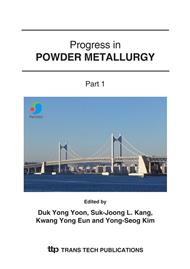p.337
p.341
p.345
p.349
p.353
p.357
p.361
p.365
p.369
Effect of Residual Carbon on the Microstructure Evolution during the Sintering of M2 HSS Parts Shaping by Metal Injection Moulding Process
Abstract:
In this present investigation, Metal Injection Moulding (MIM) of M2 High Speed Steel (HSS) parts using a wax-High Density Polyethylene (HDPE) binder is shown. This work is focused on the examination of the sintering densification and microstructure evolution of the parts. The injection molding process of the feedstock has been optimized to obtain high quality green parts. The elimination of organic binder was carried out by thermal debinding under inert atmosphere. In order to keep carbon in the sample that could improve the sintering process, incomplete debinding was performed between 450 and 600 °C. The specimens were sintered at temperatures between 1210 and 1280oC in high vacuum atmosphere, obtaining the 98% of the theoretical density. A homogeneous distribution of fine M6C carbides was obtained as well as V-rich carbides (MX) during sintering which reinforced the HSS and hence increasing the mechanical properties of the parts. In the samples with higher residual carbon content, the sintering window was extended up to 20 degrees and the optimum temperature was lower.
Info:
Periodical:
Pages:
353-356
Citation:
Online since:
January 2007
Authors:
Keywords:
Price:
Сopyright:
© 2007 Trans Tech Publications Ltd. All Rights Reserved
Share:
Citation:


